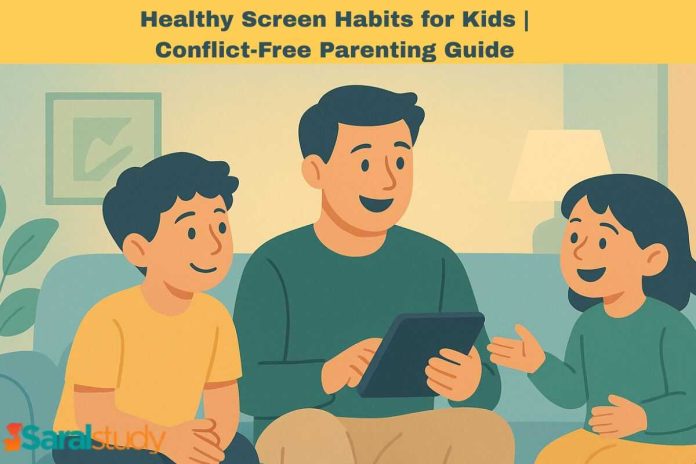Did you know? The average teenager spends 7 – 8 hours daily on screens . That’s almost like working a full – time job in front of a screen – except kids aren’t earning a paycheck; instead they’re often trading sleep, focus and health for digital time.
In today’s world, screens are everywhere – TV, smartphones, tablets, laptops and even schoolwork online. While technology can be educational and fun, it can also spark daily battles between parents and kids: “One more video, please!” … “But I’m playing with friends online!” … “You’re so strict!”
If this sounds familiar, you’re not alone. Most parents struggle to set healthy screen time rules without causing arguments or resentment. The good news? With the right approach, talking to kids about screen time doesn’t have to turn into conflict. Instead, it can become a chance to teach balance, responsibility and self-control.
Let’s explore research-backed, practical strategies you can start using today.
Why Screen Time Conversations Often Lead to Conflict
Before we talk about solutions, it’s important to understand why screen time discussions trigger arguments in the first place.
- Screens feel addictive. Apps and games are designed to release dopamine, the “feel-good” hormone making it hard for kids to stop.
- It feels like punishment. When parents suddenly cut off screen time kids may feel controlled instead of understood.
- Lack of involvement. If screen time rules are imposed on kids instead of with them, they naturally resist.
Crazy fact: Blue light from screens tricks the brain into thinking it’s daytime, which is why kids feel “wide awake” even past midnight. That’s why simply saying “Go to bed now!” rarely works your child’s brain is literally confused.
How to Talk About Screen Time Rules Without Conflict
Here are some tested strategies to make conversations smoother and more effective.
1. Start With Empathy, Not Screen time rules
Instead of saying, “You’re always on your phone!”, try:
“I know watching videos and playing games is fun for you. Let’s find a way to enjoy it and still have time for sleep, study and play.”
When kids feel heard first, they’re more open to cooperation.
2. Create Screen time rules Together
Research from the University of Michigan (2020) shows that when children co-create rules with parents, they are 3x more likely to follow them without arguments.
So instead of enforcing “No screens after 9 PM,” ask:
“What time do you think is good for us to turn off devices so we can sleep better?”
This makes screen limits feel like a family decision not a punishment.
3. Focus on Benefits, Not Just Restrictions
If you only talk about the dangers of screen time, kids may tune out. Instead, highlight the positive side of balance:
- “Less screen time means more time to play football with friends.”
- “Sleeping on time helps you do better in exams.”
- “Spending time together as a family is fun and relaxing.”
Science says: Kids who spend more time outdoors have better problem-solving skills and longer attention spans than those glued to screens. So when you promote outdoor activities, you’re not just reducing screen time – you’re boosting brain power.
4. Use Screen-Free Zones
Instead of fighting over hours, create screen-free times and spaces in the house:
- No screens during meals
- Screen-free bedrooms at night
- Tech-free family outings
Interesting twist: Families that set “screen-free dinners” not only eat healthier but also report stronger communication and bonding.
5. Model Healthy Screen Habits
Children copy what they see more than what they hear. If parents are scrolling at the dinner table or binge-watching late at night, kids won’t take screen rules seriously.
Instead:
- Keep your phone away during meals.
- Avoid late-night scrolling.
- Talk openly about how you manage your own screen habits.
This shows kids that screen balance is a family value, not just a rule for them.
6. Explain the Science Behind It
Kids are naturally curious. Instead of just saying “Too much screen is bad,” explain what actually happens:
- “Your eyes get tired because the screen light makes them dry.”
- “Too much gaming makes your brain tired, so studying feels harder.”
- “When you sleep late, your brain can’t recharge and you feel cranky.”
Did you know? Just like junk food can make us feel cranky and foggy, too much screen time overloads the brain, leaving kids restless and unfocused.
When kids understand the why, they’re more likely to follow the what.
7. Replace, Don’t Just Remove
Instead of simply saying “No screens,” offer fun alternatives:
- Board games or puzzles
- Family walks
- Cooking together
- Reading a funny comic
Kids resist less when screen time is replaced with something equally engaging.
8. Keep Conversations Calm
If arguments start, step back instead of escalating. Try:
“I see you’re upset right now. Let’s take a break and talk later when we’re both calm.”
This prevents screen time talks from turning into power struggles.
9. Encourage Screen Time With Purpose
Not all screen time is bad. Differentiate between passive screen time (mindless scrolling) and active screen time (learning, creating, connecting with friends). By setting screen time rules, create boundries between them:
Teach your child to ask:
“Am I learning, creating, or just wasting time?”
This builds self-awareness and helps them regulate on their own.
10. Praise Efforts, Not Just Outcomes
Instead of only noticing when they break the rules, appreciate when kids show balance:
- “I like how you turned off the TV on time today.”
- Great job finishing homework before playing games.”
Positive reinforcement motivates kids far better than constant criticism.
Bonus Parenting Tips
- Use timers and apps that remind kids to take breaks.
- Encourage hobbies that don’t involve screens – music, art, sports.
- Keep communication open: let kids know they can always talk about peer pressure or online issues.
Cool fact: Families who treat screen discussions as teamwork instead of rules report fewer conflicts and more cooperation.
Conclusion
Talking to kids about screen time doesn’t have to feel like a daily battle. With empathy, co-created rules and positive alternatives, you can guide your child to build a healthy relationship with technology.
Remember, the goal isn’t to completely remove screens-it’s to teach balance and smart habits that will serve them for life.
So the next time your child asks, “Just 10 more minutes, please?” – you’ll have the tools to respond with calm, confidence and cooperation.
Also Read: Tips For Parents: How to Handle a Call from Child’s School





